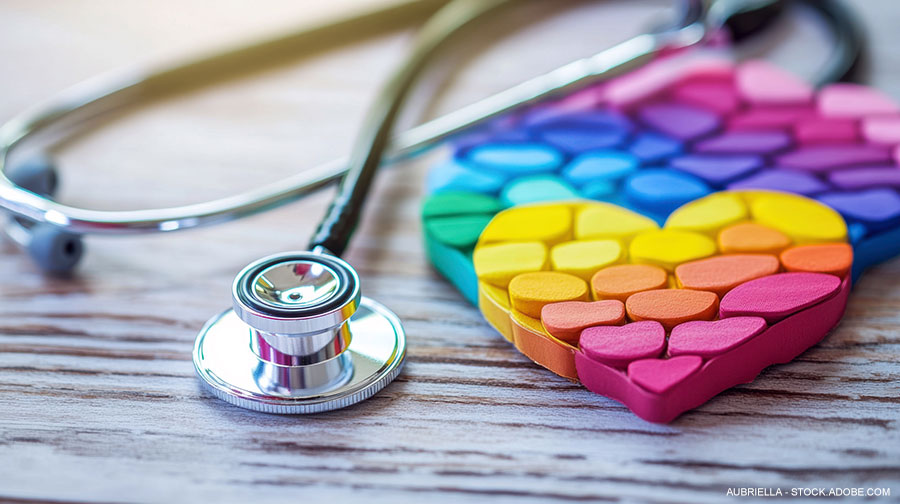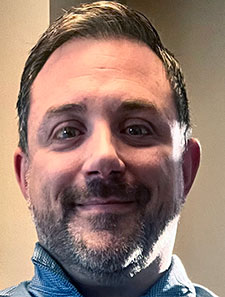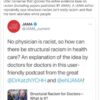 During his adolescence in conservative Virginia, Ian Jenkins felt isolated and alone as he began getting in touch with his gay identity. He didn’t know any gay people, and they weren’t portrayed on television. The surrounding culture was quite homophobic, and slurs, epithets, and unfair biases and judgements were commonplace.1
During his adolescence in conservative Virginia, Ian Jenkins felt isolated and alone as he began getting in touch with his gay identity. He didn’t know any gay people, and they weren’t portrayed on television. The surrounding culture was quite homophobic, and slurs, epithets, and unfair biases and judgements were commonplace.1
But he had a dream that one day he might be able to bring a gay partner to a holiday celebration with family members and friends without it being a big deal. He dreamt that being gay would be perceived as something akin to being left-handed—a normal variation experienced by a significant minority of the population.

Dr. Jenkins
Today, Ian Jenkins, MD, SFHM, is a hospitalist at the University of California, San Diego. He pointed out that since his adolescence, the broader culture has progressed significantly in terms of broader acceptance of individuals’ lesbian, gay, bisexual, transgender, queer or questioning, intersex, and additional related (LGBTQIA+) identities. Some real legal gains have been made, as in the case of the Marriage Equality Act and general expansions in anti-discriminatory laws regarding sexual orientation and gender identity.
But recent changes in the political climate, including efforts to target diversity, equity, and inclusion (DEI) at the national level, are creating stress and anxiety for many in the LGBTQIA+ community.

Dr. Stefani
“More than likely, it’s forcing some younger people back in the closet,” said Andrew J. Stefani, DO, a hospitalist at UnityPoint Clinic Central Iowa Hospitalists in Des Moines, Iowa. Dr. Stefani shared that some longer-term pediatric transgender patients previously seen at a local LGBTQIA+ clinic are now having to drive hundreds of miles for care they previously received in-state, due to recent state legislative restrictions on such care.
Dr. Stefani, who is out as gay, added, “It can be really disheartening, as a provider, to not be able to directly connect them to the care they need.”
The Hospitalist talked with Dr. Jenkins, Dr. Stefani, and other hospitalists about ongoing health barriers and challenges facing LGBTQIA+ individuals. They also gave insights on other important related topics, such as how hospitalists can deliver better care to these individuals, hospitalists’ role as educators and advocates, and the need to stay determined and hopeful while continuing to fight for these individuals’ well-being.
Progress in the LGBTQIA+ movement and current setbacks
The first major movements toward awareness of LGBTQIA+ health issues and disparities grew out of activism following the Stonewall riots in 1969, underscored by the formation of the Lesbian and Gay Health Foundation in 1977. As part of this movement, activists began lobbying the American Psychiatric Association to stop classifying homosexuality as a mental disorder in the “Diagnostic and Statistical Manual of Mental Disorders,” a designation that was only fully removed in 1987.2
With the devastating outbreak of Human Immunodeficiency Virus (HIV) in that same decade, the LGBTQIA+ community had to channel much of its energy into advocating for the urgent needs of the gay, bisexual, and transgender people most directly affected. Damian Crawford, MD, an out gay hospitalist with Frederick Memorial Hospital and Sound Physicians, both in Frederick, Md., shared, “These days there is much less stigma about HIV, although I don’t think it is completely gone.”
The early 80s also saw some of the first research efforts to obtain information about these populations, e.g., through the first National Lesbian Health Care Survey.2 These research gains especially accelerated in the 2010s, after a 2011 report from the Institute of Medicine underscored the need to address care inequalities.3 These research gains eventually contributed to the creation of formal clinical guidelines on topics such as perioperative hormone management. However, recent federal restraints on DEI-related research funding may stall future progress.

Dr. Damari
Nicole Damari, MD, MS, a hospitalist in Cincinnati who is out as bisexual and nonbinary, said, “We’ve also made progress in terms of folks of diverse gender and sexual orientation being more in the mainstream conversation. Even just the fact that I’m able to be out professionally is a huge deal compared to where we’ve been.”
With the modern trans-rights movement, the broader culture has also become more aware of this population and their health concerns. However, this is also a subgroup that has been targeted with some of the most pushback and weaponization in the political sphere over the past decade, with legislation targeting various aspects of trans-specific healthcare issues, bathroom access, education, sports, and other topics, accelerating especially in the past few years.
Health outcome disparities
Although some metrics have improved over the past several decades, many members of the LGBTQIA+ community still face significant healthcare disparities and challenges.
On the most basic level, societal discrimination takes a personal toll. “You can’t be fully happy and healthy if your mere existence drives people to discriminate against you and hold you in poor regard,” Dr. Jenkins said. “It causes a kind of chronic stress. Our trans community members especially feel like they are at risk in terms of their relationships, their privacy, and their healthcare, and all of that is a huge strain on them.”
On average, higher rates of mental health problems have been documented in the LGBTQIA+ community, with higher rates of depression, anxiety, and substance abuse (including tobacco, alcohol, and other drugs). Higher rates of suicide have also been found, especially in transgender and nonconforming individuals.4,5
Dr. Damari also noted that research has demonstrated that rates of suicidality increase after the passage of anti-LGBTQIA+ legislation.6 She added, “The way that society stigmatizes or does not stigmatize the community has a massive impact on mental health.”
Relatedly, a well-established body of research has shown that, on the whole, LGBTQIA+ individuals tend to demonstrate poorer medical outcomes, although this is heavily influenced by other factors like the specific subgroup and other intersecting factors, like race, education, socioeconomic status, housing insecurity, level of family acceptance, and geography.5
On average, LGBTQIA+ individuals more often engage in risky sexual behaviors, and they report higher rates of forced sexual contact, especially transgender, nonbinary, or gender-questioning individuals.7
Lesbians and bisexual women have a higher prevalence of several cancer types, and rates of multiple kinds of cancer are also higher in gay and bisexual men. These individuals also have higher rates of transmission of sexually transmitted infections such as HIV and viral hepatitis, as well as higher rates of body image and eating disorders.5
Transgender people also face specific needs related to their body modification process, such as hormones, hormone blockers, binders, and surgeries. Transgender women, especially, may experience particularly high rates of discrimination, violence, and poor health outcomes.5
Importantly, maladaptive coping mechanisms such as substance abuse, risky sexual behaviors, and self-harm may relate to previous negative experiences of personal rejection, victimization, and discrimination.5
 Lack of access to informed care
Lack of access to informed care
Although the reasons for poorer health outcomes are likely multifactorial, the lack of access to LGBTQIA+ informed health centers is likely one contributing cause. Many people in the community report feeling uncomfortable in the healthcare system due to perceived discriminatory and biased attitudes and culturally inappropriate care.5
“I’ve met patients who didn’t seek any HIV care because they did not trust doctors and felt rejected by the medical system,” Dr. Jenkins said. “I’ve seen trans patients who stopped seeking care because they felt like they wouldn’t be accepted by their doctors, or at a minimum, didn’t think their doctors would know what to do about their special needs.”
Unfortunately, Dr. Stefani noted this distrust may be heightened in the current climate. He explained, “To comply with federal funding mandates, organizations may have to draw back some of their inclusive language. But that also sends a devastating message to patients, who might not feel as comfortable going there.”
Dr. Stefani noted that in addition to providing informed and compassionate care oneself, it can be helpful to maintain a list of practitioners who excel with LGBTQIA+ patients for referral post-hospital stay, especially if one is practicing in a more conservative region of the country. These do not necessarily need to be clinics with specific LGBTQIA+ designations, he added.
Although relative rates of coverage have improved with the Affordable Care Act and marriage equality, LGBTQIA+ patients may also be more likely to lack adequate health insurance, as plans may not cover non-traditional families or certain health services;8 this is especially true for transgender individuals, which can cause them to delay or forego needed care due to cost.
Creating inclusive environments and building rapport
LGBTQIA+ youth who live in supportive homes have much better mental health outcomes than those who do not; moreover, individuals without family support who do have other forms of support also fare better.9 “I think that it really provides evidence that simply by affirming somebody’s identity and creating a psychologically safe space, you can have a positive impact on their mental well-being,” Dr. Damari said.
Thus, although practitioners can’t change the external challenges faced by these groups, they can forge positive physician-patient relationships to positively influence their mental and physical health.
“If you don’t take the time to show that you care about someone, they may not be forthcoming about their medical issues,” Dr. Jenkins said. “That could cause misdiagnoses and add hospital days. It could cause poor treatment adherence [at discharge] if people don’t think you care about them.”
Dr. Crawford stressed the value of simple human-to-human connections in building rapport, whether that’s connecting with someone from a different culture, regional identity, religious background, or someone with a different sexual or gender identity. “Even if your experience hasn’t been identical, there is always something human you can connect on,” he said.
Dr. Jenkins agreed, “Healthcare providers can find it difficult to connect. They may not feel sufficiently familiar with [LGBTQIA+] issues, and I think that that’s okay. Every trans person I’ve ever met has been understanding that others won’t know everything that they need or experience.”
Building on rapport for better sexual history taking

Dr. Herrman
Sarah L. Herrman, MD, a hospitalist at the University of California Davis Medical Center, noted that building rapport is step one in obtaining a comprehensive sexual history. Dr. Herrman is also a course director for teaching clinical skills to first- and second-year medical students, including topics such as gender-affirming care and taking inclusive sexual histories.
A full sexual history is not necessary for all LGBTQIA+ patients being seen by hospitalists, but it’s key in certain clinical contexts. Dr. Herrman noted that many trainees and even some older clinicians may be uncomfortable taking this part of the medical history, which might feel overly intrusive, but becoming competent at performing it is important for all clinicians.
A good sexual history employs open-ended questions without making assumptions, and uses specific, matter-of-fact, nonjudgmental, gender-affirming language, Dr. Herrman explained. It’s also important to be especially clear to the patient about the confidentiality of the interview. She recommends the use of the “6Ps” framework, asking questions about sexual partners, sexual practices, protection for sexually transmitted infections, past history (including sexually transmitted infections and injected drugs), pregnancy desires, and sexual pleasure or problems.10
Dr. Herrman also recommended only examining body parts relevant to the specific clinical encounter. Additionally, she noted that, if needed, pelvic or urologic exams should be performed with extra sensitivity and especially clear communication, given the increased rates of past sexual trauma in these groups.
Education
All the hospitalists discussed the importance of ongoing education on these topics. Although training for medical students and residents has increased over the past decade, many current practitioners received little to no education on health topics related to LGBTQIA+ care during medical school or residency.
Added Dr. Damari, “People in the [LGBTQIA+] community have unique elements of their culture, practices, and risk factors that impact their health. We need to be knowledgeable about those and provide specific care, but we don’t always get good education about those topics.”
Education gaps can include both direct management techniques (e.g., hormone management perioperatively) or more subtle aspects, such as using more welcoming gender-inclusive language. To remedy these, clinicians may need to take the initiative to seek out educational resources, such as those of the National LGBTQIA Health Education Center.
Dr. Crawford acknowledges that this gap may feel intimidating to some physicians who feel less knowledgeable and comfortable on these topics. But he urged, “Just have the same curiosity you would have about another topic you don’t understand in medicine—like an unusual leukemia. That way, you can learn and provide good medical care.”
Dr. Jenkins added, “I encourage providers to stay out of judgment, be open and curious, and relax. I face clinical uncertainty or unfamiliar problems all the time. You’re not supposed to know everything.”
Dr. Herrman noted that others in the environment may need additional education as well. “You could be a provider who is providing excellent, inclusive care and creating a safe environment. But if your ancillary staff is not educated—for example by using the wrong name or pronouns—that’s still a negative healthcare interaction.” When needed, it’s important to give feedback to others about creating safe and inclusive environments, gently drawing it to their attention if something misses that mark.
Holding on and moving forward
Dr. Damari urges hospitalists to take seriously their role as advocates for all their patients, including members of the LGBTQIA+ community. “I think both individually and through institutions and advocacy groups, we can help translate studies so that patients and the public and legislators can be informed about what the data really mean for the health of [LGBTQIA+] people.”
To LGBTQIA+ practitioners working or considering working in more conservative areas of the country, Dr. Stefani encouraged, “That visibility is important. Your presence there matters just as much now, if not more so, and there are pockets of support wherever you go.”
“We can’t give up all hope and all efforts to improve,” he added. “But we may need to temporarily recalibrate to goals that are attainable, even if they’re smaller or different in scope.”
Dr. Damari agreed, “It’s important that we hold on to the progress [on LGBTQIA+ issues] that we have made and not take steps backwards, because I think there is still a long way to go.”
Ruth Jessen Hickman, MD, is a graduate of the Indiana University School of Medicine in Bloomington, Ind., and a freelance medical writer.
Additional Tips for Creating Safe Environments
- Don’t make assumptions about anyone’s sexual orientation or gender identity, or make assumptions about their practices or lifestyle based on these.
- Ask to be introduced to everyone in the room, without making assumptions about people’s connections or family life.
- Ask people how they would like to be addressed as a basic courtesy. If you’re unsure of what pronouns to use, just ask. Apologize if you make a mistake, but don’t make it a big deal.
- Use a relaxed and open body posture and empathetic tone of voice to help connect.
- Ask open-ended questions.
- If you are out, feel free to share a detail of your personal life that signals you are in the LGBTQIA+ community.
- Use visual signals to indicate a LGBTQIA+ friendly environment.
- Be sensitive and respectful when asking about potentially delicate topics.
- If people share experiences of past unpleasant healthcare encounters or other sources of bias or trauma, express empathy without downplaying their concerns.
- Maintain confidentiality and do not inadvertently out a patient who is not out, except if medically necessary.
References
- Jenkins IH. Reflections on marriage equality. Ann Intern Med. 2016;164(2):129-30. doi:10.7326/M15-1687.
- Landers S, Kapadia F. 50 years after Stonewall, the LGBTQ health movement embodies empowerment, expertise, and energy. Am J Public Health. 2019;109(6):849-850. doi:10.2105/AJPH.2019.305087.
- IOM (Institute of Medicine). The Health of Lesbian, Gay, Bisexual, and Transgender People: Building a Foundation for Better Understanding. Washington, DC: The National Academies Press; 2011. Available at: https://nap.nationalacademies.org/resource/13128/LGBT-Health-2011-Report-Brief.pdf. Accessed April 23, 2025.
- Narang P, et al. Suicide among transgender and gender-nonconforming people. Prim Care Companion CNS Disord. 2018;20(3):18nr02273. doi:10.4088/PCC.18nr02273.
- Medina-Martínez J, et al. Health inequities in LGBT people and nursing interventions to reduce them: A systematic Review. Int J Environ Res Public Health. 2021;18(22):11801. doi:10.3390/ijerph182211801.
- Lee WY, et al. State-level anti-transgender laws increase past-year suicide attempts among transgender and non-binary young people in the USA. Nat Hum Behav. 2024;8(11):2096-2106. doi:10.1038/s41562-024-01979-5.
- The Trevor Project. Sexual violence and suicide risk among LGBTQ+ young people. The Trevor Project website. https://www.thetrevorproject.org/research-briefs/sexual-violence-and-suicide-risk-among-lgbtq-young-people. Published March 27, 2024. Accessed April 23, 2025.
- Bolibol A, et al. Health insurance coverage and access to care among LGBT adults, 2013-19. Health Aff (Millwood). 2023;42(6):858-865. doi:10.1377/hlthaff.2022.01493.
- McConnell EA, et al. Families matter: Social support and mental health trajectories among lesbian, gay, bisexual, and transgender youth. J Adolesc Health. 2016;59(6):674-680. doi:10.1016/j.jadohealth.2016.07.026.
- National Coalition for Sexual Health. Sexual health questions to ask all patients. NCSH website. https://www.nationalcoalitionforsexualhealth.org/tools/for-healthcare-providers/sexual-health-questions-to-ask-all-patients/. Updated November 22, 2023. Accessed April 23, 2025.
